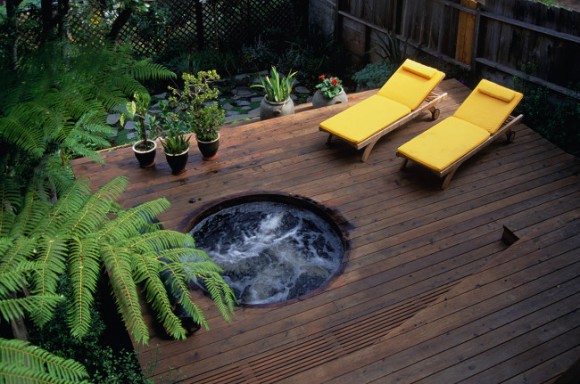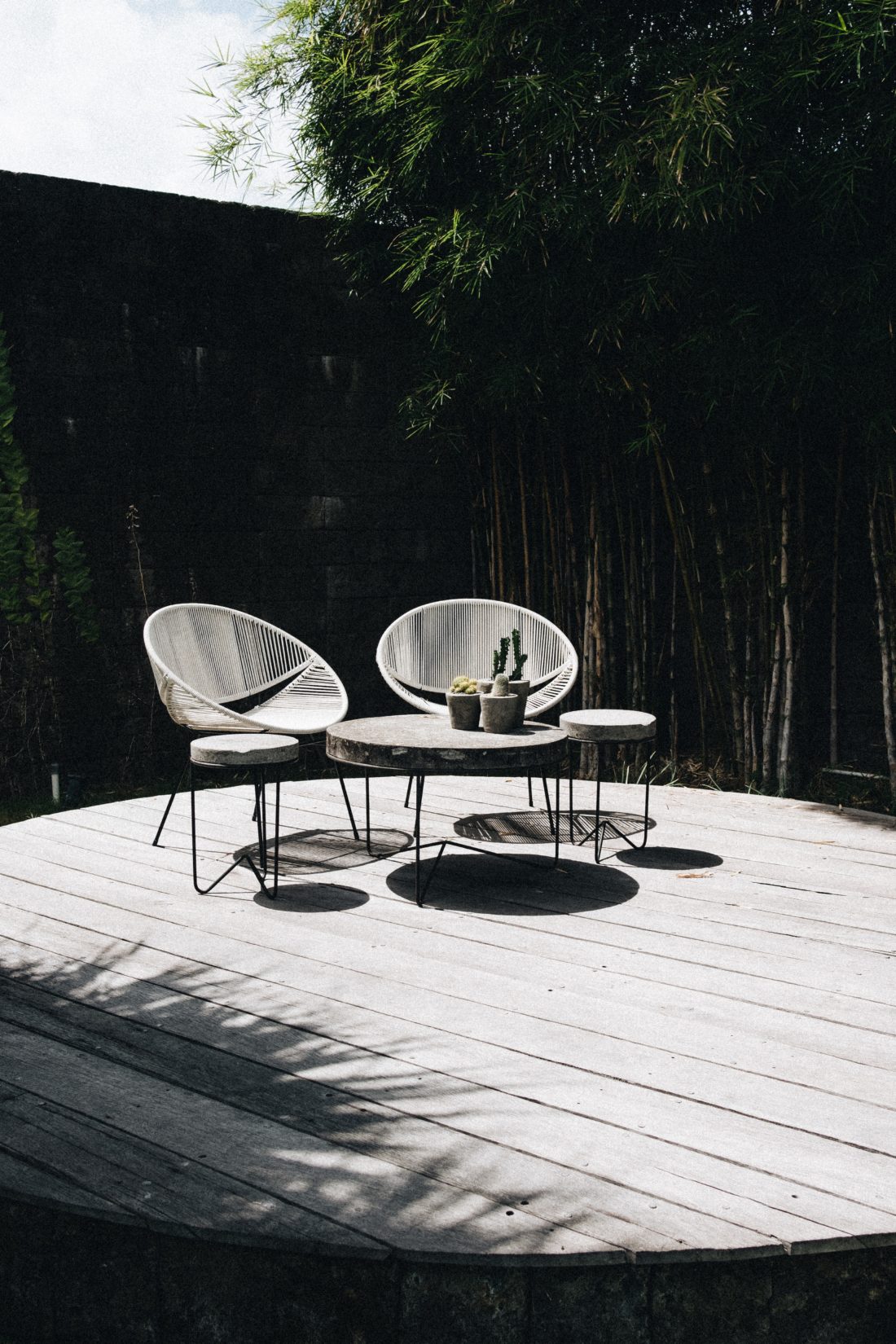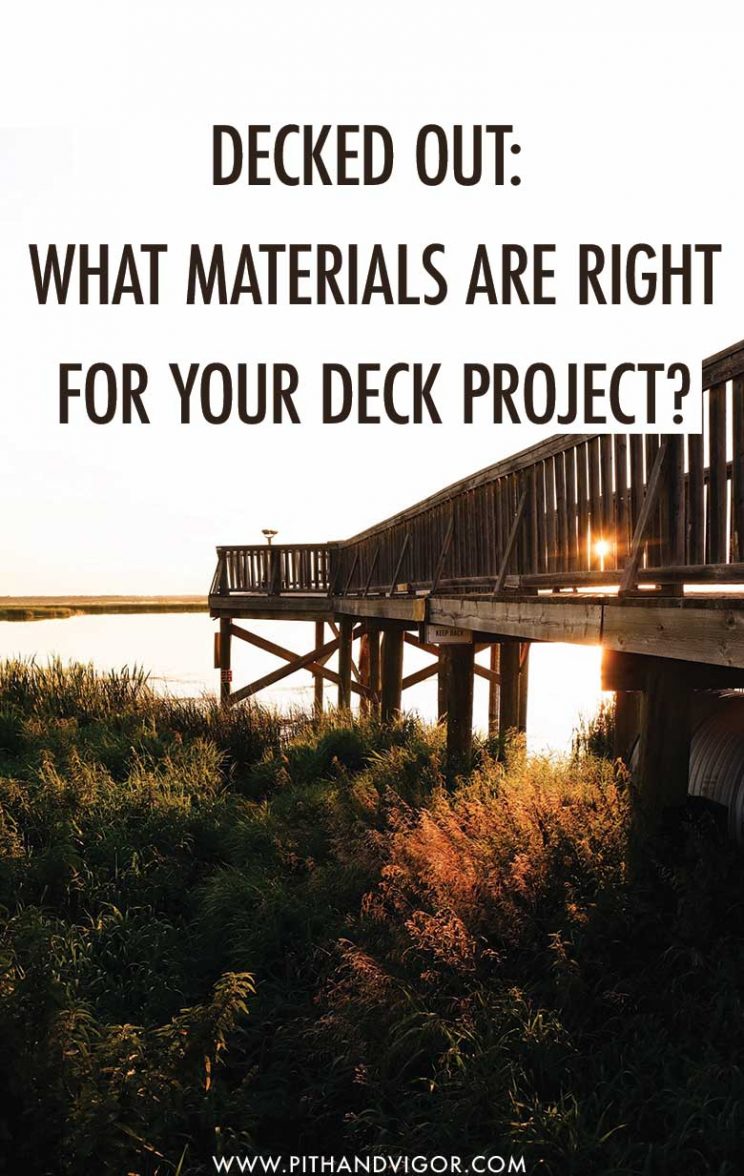Are you considering adding a deck to your garden? What deck materials or finish is right for you? What is right for your project? How do you figure out what to do?
This guide will help.
A Guide To Patio Decking Materials
There are four basic options for decking material—painted fir, hardwood, synthetic material, or treated wood.
Within those four options is a second round of decision-influencing options—finish, texture, color, and cost.

One might think the latter (cost) would drive the decision, but often costs can be deceiving. For example, some have a higher initial cost, but are much lower maintenance. As a result, we find ourselves dealing with several additional considerations—high cost/high maintenance, high cost/low maintenance, low cost/low maintenance, low cost/high maintenance, and more!
So where to begin?
What are the options, and what are the factors to evaluate?

Painted Fir Decking
Historically, this is the material of choice for millions of homes all over the United States. While this is often a great choice, there are several considerations. For one, painted fir is best used for covered porches; painted wood will deteriorate faster if not protected from the weather.
In addition, the material available today is younger and less dense than the material available 60 to100 years ago. As a result, fir decking today does not have the longevity of decks installed decades ago. That being said, technology has come a long way in developing deck paints and stains that help keep a painted fir porch looking great for years.
Pros
- Great option for historic homes or homeowners trying to create an “old time” feel
- A great way to introduce color to your exterior structure
- Moderately expensive.
Cons
- Will need to be re-painted every 5 to 8 years depending on use
- Requires an experienced painter to achieve a successful finish

Hardwoods
Some hardwoods are more readily accessible than others depending on your geographic region. Common options are IPE, teak, redwood, cedar, and walnut. IPE—a Brazilian hardwood—is the newest member of the group. IPE—like teak—will weather to a silvery grey if not maintained. When first installed and sealed, IPE is a rich, beautiful deep brown. While many love its sophisticated look, you need to know that IPE will need to be re-sealed once a year in order to sustain that look. If not maintained, it will start to change color, which can de-formalize the appearance of the space. IPE is incredibly weather resistant, and can be installed in large, uncovered areas. It rarely splinters, and there are many different installation methods available depending on the application.
Pros
- Long-lasting
- Sophisticated appearance
- Elegant installation
- Rich mahogany color when first finished
Cons
- High cost
- High maintenance responsibility and cost possible (if initial color is to be maintained); Low maintenance cost if silvering acceptable

Synthetic or Composite Deck Boards
Synthetic decking technology has come a long way. While UV-resistance and fading were an issue when synthetic decking first appeared on the market, this problem has largely disappeared. Still, it pays to do product research and make sure the options you are considering have addressed this original flaw. Of all the options, synthetic decking is by far the most debated in the design and construction industry. The biggest concern is the plastic feel and, quite frankly, the fact that it is “fake” wood. There is no doubt that there are applications where this is the best option— docks, decks adjacent to large bodies of water, or in coastal areas where humidity is a factor. So does synthetic decking make sense for your project? It is a very personal decision.
If the application is contemporary, this can be a fantastic option; synthetics without a wood grain can make a very streamlined, high-style impact with an array of thought-provoking colors. If you prefer a more traditional application, there are convincing wood grains with colors that mimic a hardwood deck with no maintenance requirements.
Pros
- True color
- No maintenance
- The most weather-resistant option on the market
- Recycled content available
Cons
- Material does not appeal to everyone
images: Stainted Pressure Treated Wood, Composite Decking, Washington Deck Tiles
Treated Deck Boards and Wood
Treated wood has long been the go-to choice for a standard deck. There are a lot of great ways to transform this common material into a fantastic design option that may quite possibly be the best option considering aesthetics, cost, and maintenance. New lines of exterior stains have transformed the standard 10 “wood colors” into an array of exciting hues— from sophisticated greys, to playful teals, pinks, and purples. Each color is also available in grades of saturation—from translucent to opaque. These stains have revitalized treated lumber as an option that can be both weather-resistant and a beautiful extension of your home and personality.
Pros
- Low cost
- Durable long-lasting wood
- Fantastic color options
- Low maintenance when stain is used.
Cons
- Not as long-lasting as hardwoods or synthetics
- Reputation for being “common”
Note: By treated wood, I am referring to ACQ-wood that features a water-based preservative, not CCA-treated wood.


What’s Decking Materials are Right for You?
So where do you land in this decking dilemma?
Weigh the options. First, determine what is the main factor driving your decision: is it cost, design aesthetic, or maintenance responsibilities? Prioritize these three key factors, and then rate each category. You will be able to find an installation that works for your home, the way you live, and your budget.
You might alsolike these posts about decking:
Images David Yama; deck design by David Yama and Robert Shepherd, Photo by Mika , Photo by Sonnie Hiles, Photo by Birgit Loit, Photo by Camylla Battani.
and by Ezra Jeffrey on Unsplash
by Shelley Hasten for PITH + VIGOR

I am always looking for good DIY tutorials; the thoroughness of your information was greatly appreciated.